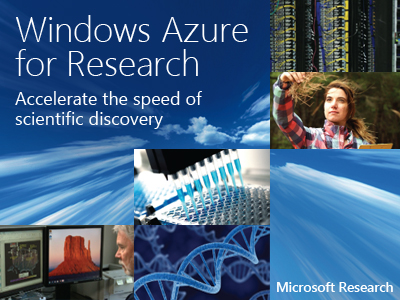Cloud computing for researchers made easy: what, why and how?
Posted on 30 January 2014
Cloud computing for researchers made easy: what, why and how?
 By Kenji Takeda, Microsoft Research
By Kenji Takeda, Microsoft Research
There’s a lot of talk about cloud computing, but what does it really mean for researchers? Of course, it’s not about the technology, but what we are trying to achieve with it. This varies enormously across disciplines, teams, and individual researchers, but the same stories come back time and time again: meeting paper deadlines, reproducible research, data sharing, and now big data.
What is cloud computing exactly? Well, it can be defined in different ways, but from a researcher’s perspective a nice way of summing it up is: getting what you need, when you need it.In this case, the what is being able to get your research results. This might be from collecting data, pre-processing, running analyses, visualising them, and getting them ready to present in a paper. Or you could be running a large set of computational simulations having spent weeks or months perfecting the code and figuring out which parameters you need to investigate in detail. This is all possible now, but a key difference with using the cloud is the immediate availability of computing and data resources, at scale. Even those in the best resourced research teams in the world can find it difficult to complete work when deadlines are looming, or somebody else is ahead of them in the compute queue. And for those who don’t have access to everything, cloud computing can help level the playing field and make everyone’s research fly.
How?
From our work on Fourth Paradigm data-intensive science and the exciting developments of Science 2.0 and Open Science, it has become clear that cloud computing can play a new role in researchers' lives. So at Microsoft Research we are working with the community to help researchers better understand how cloud computing can help you go beyond the desktop, share research data, and improve collaboration.
Last week we hosted 45 researchers at the Oxford e-Research Centre (as described in a forthcoming post from Philip Fowler), where everyone got hands-on with Windows Azure deploying Linux virtual machines, running IPython, scaling out R and MATLAB calculations, playing with cloud storage, and sensor stream and big data processing with Hadoop, STORM and Kafka. We’re looking forward to our next two-day training session at the University of Manchester on 3-4 April 2014 as part of our global programme. You can register online for the Manchester event.
If you can’t make our courses, we’ve released all of the training material as open source. We also have a webinar series with more episodes coming soon, and technical papers that drill down into more detail.
Even more exciting are the 75 Windows Azure research projects we are supporting across the world, including ten in the UK (so far!) spanning everything from environmental data, flood modelling and risk analysis, to catching cheats at chess, genome analysis and reproducible research. Each of these projects receives thousands of compute hours, and/or terabytes of data storage, to develop, test and pilot their cloud computing projects at scale over 12 months.
You can get involved too, the next deadline is 15 February 2014 and every two months after that: just apply here with a short proposal.
We’re looking forward to meeting you online on LinkedIn & Twitter (#azureresearch), and hopefully in–person, to see if cloud computing can help you with your research - www.azure4research.com.
